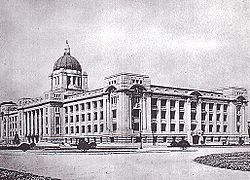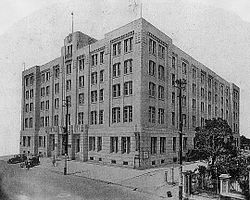- Oriental Development Company
-
Oriental Development Company Former type Public Industry International trade Founded 1908 Defunct 1945 Headquarters Tokyo, The Empire of Japan Oriental Development Company (Shinjitai: 東洋拓殖株式会社, Hangul: 동양척식주식회사, Hanja: 東洋拓殖株式會社), established by the Empire of Japan in 1908 is a national enterprise which was built as one of colonial exploitation policies[1] towards the Korean Empire and other countries in East Asia. The headquarter of the company was naturally headquartered in Tokyo.[2]
Contents
Foundation
In 1905, the Empire of Japan made a treaty with the Korean Empire called Eulsa Treaty. As a result, the Korean Empire became a protectorate of the Empire of Japan.[3] This treaty deprived Korea of its diplomatic sovereignty.[4][5][6]
Not only that, this treaty also allowed the Empire of Japan to build the Japanese Government-General Building in Seoul, and dispatched a resident-general there.
This treaty gave rise to the foundation of Japan-Korea Treaty of 1907, and soon, the National Diet of Japan passed the bill about the establishment of Oriental Development Company on March 1908. After the law was passed, the Imperial Japan forced the government of Korea to sign up the treaty. Even though it used to be managed by both the Korean Empire and the Empire of Japan, when the headquarter was moved to Tokyo in 1917, it became owned by only the Empire of Japan.
In 1927, a Korean independent movement activist, Na Seok-ju threw bombs inside the Oriental Development Company building in Seoul and killed a few managers.[7] However, soon, Oriental Development Company started to build another branches on other foreign areas such as Taiwan, Manchuria, Sakhalin, South Pacific Mandate. Eventually, they had built nine branches and hired over 800 people in 1938.
History
Migration Business
Due to the decreasing number of farmable lands in Japan, the Imperial Japan decided to establish migration policies which would help people to move to the Korean Peninsula to farm. This gave rises to a number of Japanese farmers coming to Korea. By 1917, Oriental Development Company accepted 1,000 families annually, and by 1926, they had god 260 families per year too. Therefore, Oriental Development Company accepted about 9,000 families in total by 1926.
The land in the possession of the company that had been given away to Japanese colonists up to the spring of 1924, amounts to more than 8,000 landmass and normal immigrants reach to the number of 246,767, thus put together, forming one-seventh of the whole arable land attained by Japanese migrants.[8]
After great deal of migration policies and supports, the practice of 'subleasing' came to float. The Japanese people who moved to Joseon were allowed to permit to initiate tenant farming, and then subleased such right for normal Joseon peole who have lived originally.[9]
Land Investment
See also: Cadastral Survey by the Imperial JapanAfter the Cadastral Survey had been done by the Imperial Japan, Oriental Development Company has bought one third farmable lands in the Korean Peninsula by late 1920s.[10] Soon, they forced tenants who are farming on their lands to pay over 50% of their production for farm rents, whereas the possession of Japanese migrants have sky-rocketed by 300~400 % per year across the Korean peninsula.[11]
The large amounts of landmass were started to be in grip of Japanese migrants to gain additional taxes and tenure for farmers by the authorities. The seizure of landlord class formed a sense of guild, then farmers indigneous to the region could not but lose the independent class as a farming household.
According to the research by Arthur C. Bunce, Land tenure was most popular type for farmers to go on farming since there had not been another measure to live on. 75% of Korean farmers are tenants operationg farms whose harvests would fall upon landlord.[12]
The situation of residents in Hwanghae provice(currently belonging to North Korea) is descripted in Dong-A Ilbo.
Owing to bad harvest, caused by the flood, drought, and attacks by insects, poor and wretched tenants have pleaded over a month that they must have been exempt from paying the rents, or that the rents must have been reduced, for the year. (abridged) Regardless of how old they are, most of residents came to the local office of the Oriental company and pleaded the cancellation of the tax. The local agents of the company threatened, however, that the farmers shall lose their tenant rights in case they do not pay the rents.[13]
Other Investments
After the occurrence of Mukden Incident in 1931, the Imperial Japan started to plan on transforming the Korean Peninsula into a supply base. Soon, Oriental Development Company also participated in these plans by investing on electricity and railroads to exploit mines in the Korean Peninsula.
Aftermath
Oriental Development Company building, Tokyo.
After Korea was liberated by the Allies, the United States Army Military Government in Korea decided to confiscate all the properties from Oriental Development Company in 1945.[14] Soon, this became Shinhan Gongsa, which were located in 6 major cities of South Korea.[15] It later owned and controlled the landmass of Oriental company with those of Japanese landholders.
After the First Republic of Korea (South Korea) was established, the lands belonged to Oriental Development Company were distributed to farmers in 1949 by the Land Reform.[16]
Currently in South Korea, the Oriental Development Company still exists in Busan[17] and Mokpo.[18] Two buildings are both operated by modern history museum to record several incidents during Japanese colonial rule. The counterpart in Seoul is now occupied by Korea Exchange Bank.
See also
- Eulsa Treaty
- Japan-Korea Treaty of 1907
- Korea under Japanese rule
- List of territories occupied by Imperial Japan
Footnotes
- ^ F.A.MOKENZIE, p.195 «Korea's Fight for Freedom» Yonsei University
- ^ (English) Hong I sup, p.220 part.18–1 March First Movement, «Korea's Self Identity»
- ^ The history of Korea, pp.461~462, by Homer Hulbert
- ^ "Deoksu Jungmyeongjeon". 2008-06-23. http://joongangdaily.joins.com/article/view.asp?aid=2891414. Retrieved 2009-05-04.
- ^ Uk Heo, Terence Roehrig (2010). South Korea Since 1980. Cambridge University Press. pp. 9. http://books.google.com/books?id=Jegq3veJU2wC&pg=PA100&dq=%22Eulsa+Treaty%22&hl=en&ei=A5Z0TPypNsWXcfmXtZ8G&sa=X&oi=book_result&ct=result&resnum=9&ved=0CE4Q6AEwCA#v=onepage&q=%22Eulsa%20Treaty%22&f=false.
- ^ "Independence leader Kim Koo". 2008-04-28. http://www.ivynews.kr/news/news_main.html?number=41&code=feature. Retrieved 2009-05-04.
- ^ Movement of Activist- Na Seok Ju Independence Hall of Korea, Retrieved on 2011-06-09
- ^ On colonial Poplicy Dong-A Ilbo 1924-12-13
- ^ (English)Footnotes, The survey of government owned land in Changwon county under Japanese colonial rule Lee Young Ho
- ^ Yoo Young Ik, «Syngman Rhee and Ahn Ch'ang-ho : A Profile of Patriotism in Conflict_Robert Hyung-chan Kim», Yonsei University pp.601
- ^ (English)Korean Land and Korean People Dong-A Ilbo 1924-01-28
- ^ Far Eastern Survey- JSTOR.org Arthur C. Bunce, The Future of Korea: Part 2, pp.85
- ^ (English)The Inhumanity of the oridental dvelopment company 1924-11-11 Dong-A Ilbo
- ^ (English)An Evaluation of the U.S. Occupational Policy toward Korean Peninsula 1945-1948 Shin Bok Ryong
- ^ (English)The Agricultural Management of the New Korea Corporation ( Sinhan Gonsa ) in North Kyongsang province between 1946~1948 Song Kyung Hee pp.53, 54
- ^ (English)‹Peasant Movement and Land Reform during the U.S. Army Military Government in Korea› Abstract - Bang Young Hyuk
- ^ Busan Modern History Museum Info Destination Guide - Retrieved on 2011-06-09
- ^ Mokpo: An Outdoor Museum of Colonial Korea 2008-08-10, Robert Koehler Retrieved on 2011-06-09
Categories:- Korea under Japanese rule
- Japan–Korea relations
- Korean independence movement
- Bilateral relations of the Republic of China
Wikimedia Foundation. 2010.



